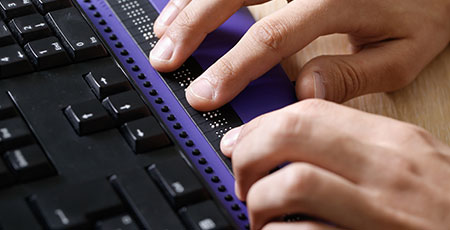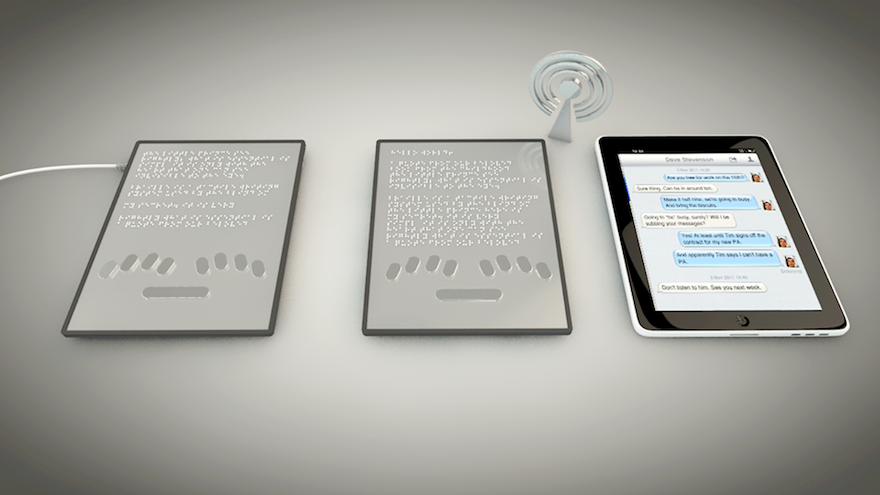An Overview to Life-Changing Assistive Innovation for the Blind and Visually Impaired
The advancement of assistive innovation has actually introduced a transformative age for individuals who are blind or aesthetically impaired, offering tools that boost autonomy and enhance everyday experiences. Technologies such as wise navigation devices and AI-driven applications are redefining exactly how users interact with their surroundings, while obtainable analysis services and wise home innovations guarantee to further elevate the high quality of life. As these innovations remain to progress, one need to consider not just their performances but likewise their effect on fostering independence and inclusivity. What does this mean for the future of availability?
Smart Navigation Tools
Smart navigating tools are revolutionizing the way people that are blind or aesthetically damaged communicate with their environment. These advanced modern technologies, which integrate general practitioners, audio responses, and haptic signals, offer individuals with important information about their surroundings, improving their self-reliance and flexibility.
One popular instance is using wise walking canes equipped with sensing units that discover barriers and give real-time comments via vibrations or audio cues. These devices allow users to navigate complicated atmospheres, such as busy roads or crowded public spaces, with raised self-confidence. In addition, wearable tools, such as clever glasses, are being established to assist in recognizing faces, checking out text, and identifying objects, better enhancing the user's spatial awareness.
In addition, smart navigating devices are increasingly incorporating man-made intelligence to evaluate data and adapt to customers' preferences. This personalized method not just improves navigation performance however also fosters a feeling of empowerment among individuals. As modern technology remains to breakthrough, the potential for wise navigating tools to produce a much more inclusive and available globe for people who are blind or visually impaired continues to be appealing, ultimately reshaping their everyday experiences and interactions.
Innovative Mobile Applications
Mobile applications are arising as powerful devices for helping individuals who are blind or visually impaired, providing a series of functionalities that boost daily living. These apps harness advanced innovation to facilitate everyday jobs, improve accessibility, and advertise independence.
One group of innovative mobile apps concentrates on visual recognition. Applications like Be My Eyes connect individuals with sighted volunteers via video calls, making it possible for real-time support for tasks such as reviewing labels or navigating unknown environments. Similarly, applications like Seeing AI use man-made intelligence to explain environments, checked out message, and identify things, offering individuals with critical information at their fingertips.
An additional considerable location is navigating and positioning. Apps such as Aira and Nearby Traveler give audio support, assisting customers navigate metropolitan areas easily. They use personalized help, permitting an extra certain expedition of the atmosphere.
Moreover, health and wellness and wellness applications deal with certain needs, such as drug administration and health and fitness monitoring. These applications aim to promote a holistic method to wellness, making certain that users can preserve their health independently.
Wearable Assistive Instruments
Wearable assistive tools represent a significant advancement in innovation made to sustain people that are aesthetically impaired or blind. These tools improve wheelchair and freedom by offering real-time feedback concerning the surrounding environment. Amongst the most significant wearable technologies are wise glasses outfitted with sensing units and electronic cameras, which can identify obstacles and relay essential information with sound cues.

One more ingenious choice includes wrist-worn tools that use ultrasonic waves to find obstacles and offer navigational support. These gadgets commonly come with adjustable More Help setups, allowing individuals to customize the alerts to their specific demands.
The combination of synthetic knowledge in wearable assistive innovation is additionally noteworthy, as it constantly boosts the accuracy and responsiveness of these gadgets. Generally, wearable assistive devices are transforming the lives of the aesthetically damaged and blind, fostering higher autonomy and boosting lifestyle through ingenious options.
Accessible Reviewing Solutions
Easily accessible reading options play a crucial duty in enabling individuals who are aesthetically impaired or blind to involve with message across numerous formats. These solutions incorporate an array of tools and modern technologies designed to improve reading experiences, from standard print materials to electronic content.
One noticeable remedy is Optical Character Recognition (OCR) modern technology, which converts printed text into digital layout, allowing customers to pay attention to or check out the material utilizing display viewers. Furthermore, specialized e-readers furnished with text-to-speech capabilities use adjustable analysis experiences, allowing users to change font sizes and history shades for improved presence.
An additional reliable approach is braille display screens, which offer responsive responses by transforming electronic message into braille. This permits people to review touch, promoting better independence and access to literature. Additionally, mobile applications designed for checking out scanned files or publications can equip users with instant accessibility to a huge library of materials.

Smart Home Technologies
Smart home technologies have actually revolutionized the way individuals that are aesthetically damaged visit this page or blind connect with their living settings, boosting both self-reliance and security. These cutting-edge services utilize automation and connectivity to develop an obtainable space tailored to the needs of individuals.
Smart speakers and voice-activated assistants supply hands-free control over numerous gadgets, allowing customers to adjust temperature level, lights, and safety measures via basic voice commands. This performance lessens reliance on sighted support and fosters a sense of autonomy. In addition, smart lighting systems can be customized to deliver auditory comments or tactile cues, making it possible for individuals to browse their homes more efficiently.
Additionally, safety systems equipped with wise cameras and sensing units can send out real-time alerts to customers, enhancing personal security without demanding visual verification. Automated door locks offer satisfaction, enabling individuals to protect their homes easily.
Incorporating smart home modern technologies not just enhances daily living but additionally motivates social webpage interaction through linked devices - Screen readers for the blind. With ongoing innovations in assistive technology, the future shows up appealing, as more options will arise to further empower individuals who are aesthetically impaired or blind, making sure a much more inclusive and independent way of life
Final Thought
Finally, the improvements in assistive technology for the blind and visually impaired stand for a significant jump towards boosting freedom and high quality of life. Smart navigation tools, cutting-edge mobile applications, wearable tools, accessible reading solutions, and clever home technologies jointly cultivate an inclusive atmosphere. This assimilation of innovation not just improves mobility and daily living but additionally empowers individuals to engage totally with their surroundings, promoting better autonomy and participation in society.
Technologies such as smart navigation devices and AI-driven applications are redefining just how customers communicate with their environments, while accessible reading services and wise home modern technologies assure to further elevate the top quality of life. As modern technology proceeds to advance, the capacity for clever navigation devices to create an extra easily accessible and inclusive world for individuals who are aesthetically impaired or blind remains appealing, eventually reshaping their everyday experiences and interactions.
Wearable assistive tools represent a substantial development in innovation designed to support individuals that are aesthetically impaired or blind. Among the most notable wearable technologies are clever glasses outfitted with cams and sensors, which can identify obstacles and relay important information via sound hints.
Smart navigating devices, ingenious mobile applications, wearable tools, easily accessible analysis solutions, and smart home modern technologies collectively promote an inclusive atmosphere.
 Scott Baio Then & Now!
Scott Baio Then & Now! Danica McKellar Then & Now!
Danica McKellar Then & Now! Barbi Benton Then & Now!
Barbi Benton Then & Now! Dawn Wells Then & Now!
Dawn Wells Then & Now! Robin McGraw Then & Now!
Robin McGraw Then & Now!